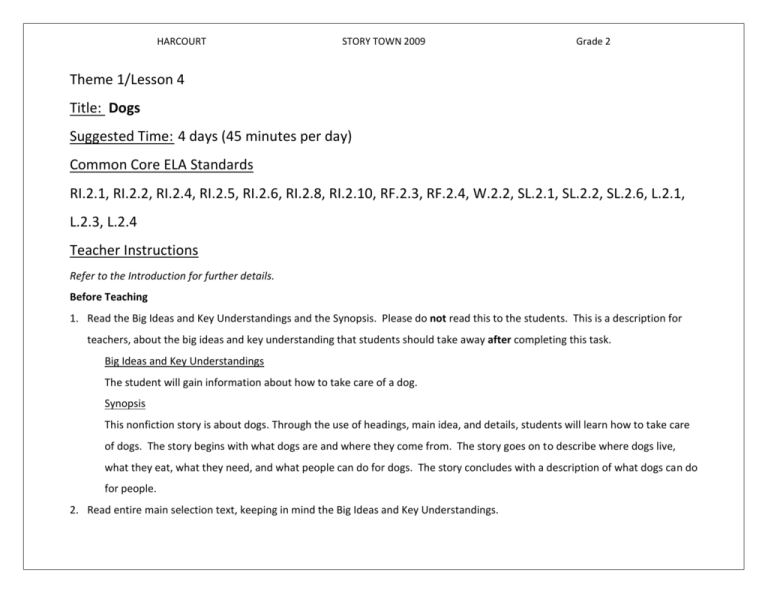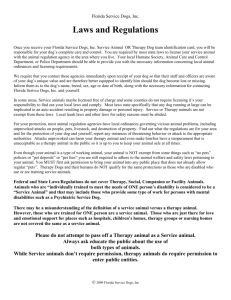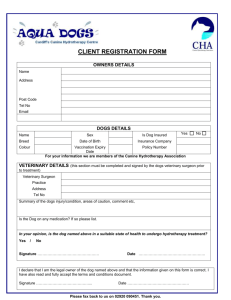HMH Storytown 2 Dogs final
advertisement

HARCOURT STORY TOWN 2009 Grade 2 Theme 1/Lesson 4 Title: Dogs Suggested Time: 4 days (45 minutes per day) Common Core ELA Standards RI.2.1, RI.2.2, RI.2.4, RI.2.5, RI.2.6, RI.2.8, RI.2.10, RF.2.3, RF.2.4, W.2.2, SL.2.1, SL.2.2, SL.2.6, L.2.1, L.2.3, L.2.4 Teacher Instructions Refer to the Introduction for further details. Before Teaching 1. Read the Big Ideas and Key Understandings and the Synopsis. Please do not read this to the students. This is a description for teachers, about the big ideas and key understanding that students should take away after completing this task. Big Ideas and Key Understandings The student will gain information about how to take care of a dog. Synopsis This nonfiction story is about dogs. Through the use of headings, main idea, and details, students will learn how to take care of dogs. The story begins with what dogs are and where they come from. The story goes on to describe where dogs live, what they eat, what they need, and what people can do for dogs. The story concludes with a description of what dogs can do for people. 2. Read entire main selection text, keeping in mind the Big Ideas and Key Understandings. HARCOURT STORY TOWN 2009 Grade 2 3. Re-read the main selection text while noting the stopping points for the Text Dependent Questions and teaching Vocabulary. During Teaching 1. Students read the entire main selection text independently. 2. Teacher reads the main selection text aloud with students following along. (Depending on how complex the text is and the amount of support needed by students, the teacher may choose to reverse the order of steps 1 and 2.) 3. Students and teacher re-read the text while stopping to respond to and discuss the questions and returning to the text. A variety of methods can be used to structure the reading and discussion (i.e.: whole class discussion, think-pair-share, independent written response, group work, etc.) Text Dependent Questions Text Dependent Questions Re-read the first sentence of the story on page 120. What makes an animal a pet? Answers Pets are animals that live with people. Re-read page 122. What detail tells you what mammals feed their babies? The sentence “Mammals make milk for their babies.” tells us that mammals feed their babies milk. A cousin is a person who is related to you. What animals are related to dogs? Page 122. Dogs are cousins to wolves and coyotes. Looking back at page 123, at what age can a puppy leave its mother to become a pet? A puppy has to be eight weeks old before leaving its mother to become a pet. According to the paragraph on page 125, to what animal does the author compare a puppy’s size? To what does the author The author compares the size of a puppy to a cat and a full grown dog’s weight to a bicycle. The author is showing us how HARCOURT STORY TOWN 2009 Grade 2 compare a full grown dog’s weight? Using these comparisons, what is the author showing us about pets? much pets will grow. Re-read the paragraph on page 126. What details does the author give about where the author’s dog sleeps? The author’s dog sleeps in her room. Her dog has two beds- a special dog bed and the author’s bed. Under the heading “What Does My Dog Eat?” on page 129, what kinds of food does the dog eat? The dog eats canned and dry dog food. How do owners keep their dogs’ teeth healthy? (page 129) Chewing the bones helps keep its teeth strong and clean. Their teeth would not be healthy if they did not chew the bones. Why does a dog need a collar and a nametag? page 130 They can be used to find a dog when it gets lost. What special items does an owner need to take his or her dog for a walk? page 130 A leash is clipped to the collar to take a dog for a walk. Exercise is one way to keep our body healthy. How can a dog get exercise?? page 132 Playing with a dog is good exercise which helps keep a dog healthy. On page 132, how does the author keep his dog’s coat clean and smooth? The author uses a special brush to brush the dog and keep its coat clean and smooth. Reread page 133. How can a dog help at home? A dog can bring in the newspaper. HARCOURT STORY TOWN 2009 Grade 2 Vocabulary TEACHER PROVIDES DEFINITION not enough contextual clues provided in the text WORDS WORTH KNOWING General teaching suggestions are provided in the Introduction Page 122 litter Page 129 canned (dog food) Page 129 special (bones) Page 132 play (with my dog) Page 132 special( brush) Page 132 coat Page 122 cousins Page 125 sugar Page 125 weigh Page 130 clipped STUDENTS FIGURE OUT THE MEANING sufficient context clues are provided in the text KEY WORDS ESSENTIAL TO UNDERSTANDING Words addressed with a question or task Page 120 pet Page 130 collar, nametag, leash Page 130 “go for a walk” Page 132 exercise Page 133 fetch Page 120 feathers Page 125 bicycle Page 126 sometimes HARCOURT STORY TOWN 2009 Grade 2 Culminating Task Re-Read, Think, Discuss, Write Write a paragraph about what you learned about caring for dogs in this story. Include at least three details from the story in your answer. You may use the following frame to help you write your paragraph. This story is about caring for dogs. I learned about how to care for a dog if I had one as a pet. There are three things I learned about dog care. First, I learned….. Then, I learned…… Last, I learned…….. This is important information because……. Answer: This story is about caring for dogs. I learned about how to care for a dog if I had one as a pet. There are three things I learned. First, I learned in order to care for a dog you must give it food, water, and bones. Then, I learned you should also keep your dog clean by brushing it with a special brush. Last, I learned dogs also need regular exercise to stay healthy. This is important information because dogs depend on us to live a healthy life. Additional Tasks 1. The students will view the Brain Pop Jr. video entitled Caring for Pets. They will complete the quizzes and additional games and activities. The class (or groups of students) will make a big book together. Each student (or each group) will choose a pet and describe how to care for that pet. 2. The students will compare and contrast dogs and coyotes. The students will take that information and write how dogs and coyotes are alike and different. Answer: They are both mammals. They both look similar (fur, size, etc.) Dogs live with people. Coyotes do not. Dogs are pets, and coyotes are not. 3. The students will brainstorm different types of pets. They will decide which pet they would like to have and write about that pet. They will tell why they chose that pet. HARCOURT STORY TOWN 2009 Grade 2 4. The students will choose 5 vocabulary words. They will write a sentence for each word and draw a picture illustrating the sentence. 5. The students will create a dog using Styrofoam cups. Directions found at http://daniellesplace.com/html/educationalcraftsmath.html. They will then write vocabulary words on the bones and write the definition on the back to place in the dog’s mouth. The students will use the bones as flashcards to study. 6. The student will discuss different types of pets. They will label the different pets on a worksheet found at http://www.enchantedlearning.com/language/english/label/pets/. 7. The teacher will allow students to choose a fiction book, such as the Clifford series, to read. The student will read the book and complete the dog book report project. Project description, directions, and printables are found at http://www.uniqueteachingresources.com/Free-Book-Report-Project-Templates.html. 8. The students will review the language skill, types of sentences, by completing “Punctuation Puppies” activity also found at http://www.uniqueteachingresources.com/Free-Book-Report-Project-Templates.html. Note to Teacher HARCOURT STORY TOWN 2009 Grade 2 1. It is recommended that the teacher check out books from the library about dogs and different types of pets to help students brainstorm for writing activities. 2. Teachers will need to buy Styrofoam cups and black pom poms for the dog vocabulary craft. 3. Content specific word from text: mammals 4. Point out to students why the author used a bag of sugar and a bicycle to make comparisons. These are items that most children are familiar with and will be more meaningful than just giving a weight in pounds or a size in inches. This will help students in their own writing. Possible Question: Why might the author have used these items to make the comparisons? These are items that most children are familiar with and will be more meaningful than just giving a weight in pounds or a size in inches







